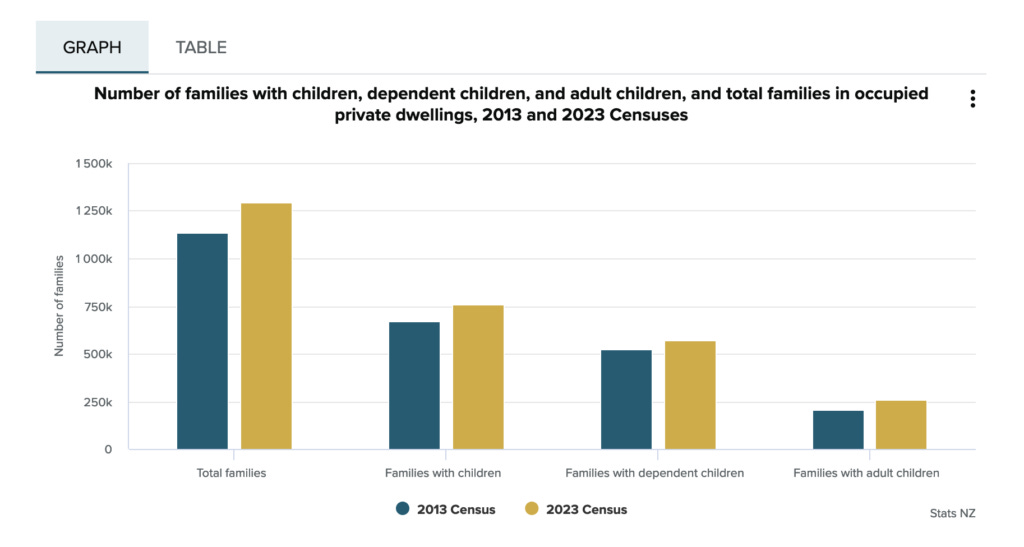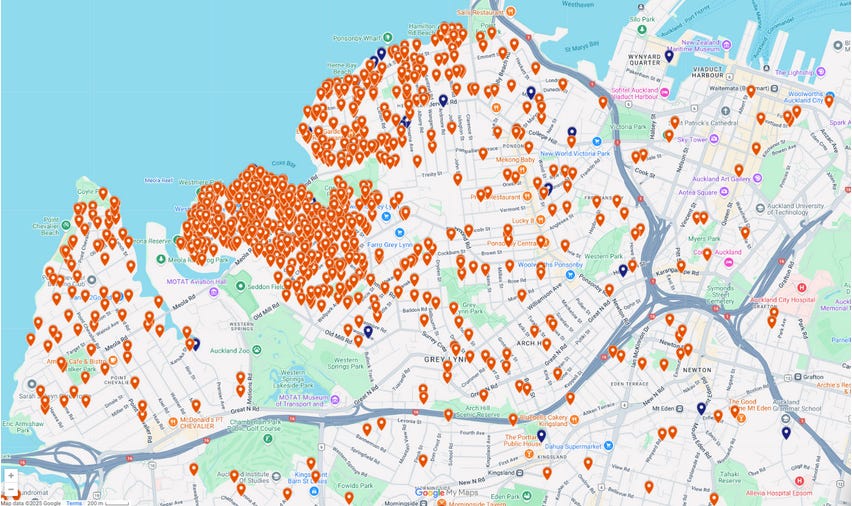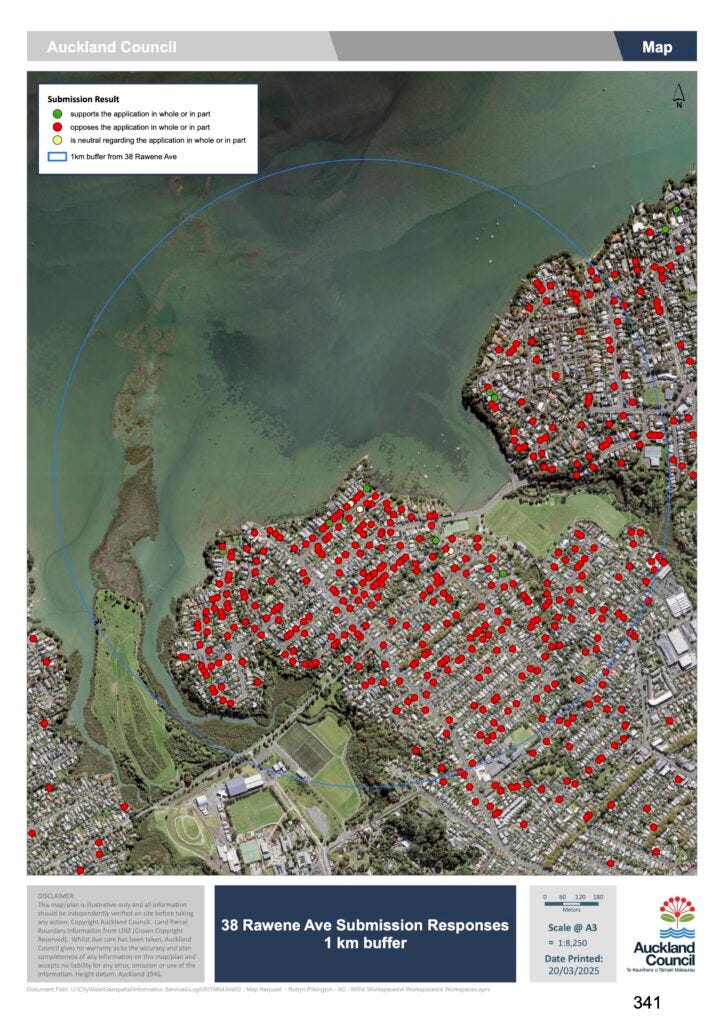An early roundup this week, on account of the long weekend ahead.
This week in Greater Auckland
On Monday we shared an open letter to Auckland Transport about Project K (further to the last-minute watering down of designs we covered last week, and AT's reply which we shared in last week's roundup.)
On Tuesday, continuing our focus on safe and attractive streets in the central city, we shared a guest post by the editor of Craccum magazine, calling for greater safety on Symonds St after a horrific recent crash
And on Wednesday Connor posted an update on our Project K open letter (signed by almost 100 people and organisations), including some of the many public comments expressing outrage and disappoint at AT's walkback on Project K.
This weekly roundup, like all of our work, is brought to you by the Greater Auckland crew and made possible by generous donations from our readers and fans. If you’d like to support our work, you can join our circle of supporters here, or subscribe on Substack!
Abandoned skyscraper rescued from ruin
In late-breaking news, a new developer has been found for the partly-completed Seascape apartment tower, the pyramid-topped skeleton of which has been lending a somewhat North Korean feel to the city skyline over the last nine months.
As reported by the NZ Herald last night (article paywalled):
Icon will replace China Construction on New Zealand’s tallest apartment tower, the $300 million-plus Seascape in Auckland, where work stopped nearly nine months ago.
A spokesman for developer Shundi Customs said a notice had been issued to all stakeholders saying that the contract with China Construction had ended.
Australian builder Icon would take over the abandoned project to complete work, he said.
This comes after recent reports of ongoing financial disputes between the original builder and developer, and concerns about the safety of the scaffolding. It’s promising news: Icon built The Pacifica close by, which started construction after Seascape and was completed in early 2021.
Why cities are great
From the Guardian, an interview-on-the-move with "Annabel Streets, the appropriately named author of a new book, The Walking Cure," which spells out how a walk around the city is as good for you as a stroll in the countryside.
“I love the opportunities for surprise,” [Streets] says, leading me out of the church, down winding backstreets.
“Urban spaces are often much more stimulating and energising than more remote landscapes,” says Streets. “Unless marred by too much noise, pollution and traffic, cities can perk us up, pique our curiosity and trigger our imagination. Yes, you can walk in a park or through mountains and feel wonderfully calm, but there are few signs of human endeavour. Cities relax us as much, if not more, because humans are fascinated by each other and the things we have created. They encourage us to get out of our own heads and distract us from our own ruminating minds.”
And this week, Patrick Reynolds spoke to the Eke Panuku podcast "A City of Neighbourhoods" about shaping the city centre and how to continue the downtown boom:
"Do more. Be more city. Lean into the city-ness. Because Auckland has a, shall we say, chequered history of urbanity. Auckland is a predominantly suburban city, and in the postwar era we nearly lost the city centre...
My formula for continuing the success - and it is a success – of the city centre is to grow higher, and to keep building and operating public transport well and efficiently (including 24-hour operations, for the night city)... It's quite plain what's working."
Low traffic / high impact neighbourhoods
Some great numbers in this overview of the measurable impact of low-traffic neighbourhoods :
Magical things happen when walking and cycling are safe and convenient. Here’s what happened in some communities in the UK:
✅ 51% drop in vehicle traffic inside the neighborhoods.
✅ Over 2-3 years, 20% reduction in car use.
✅ No delays in emergency response times.
✅ Oxford: public support was 5-to-1.
✅ Britain: public support was 6.5-to-1.
✅ People are opting out of driving for their short trips. Walking increased 115 minutes per week; cycling increased 20 minutes per week.
Like the T-shirt says, no conspiracy - just lazy!
This one neat trick for making all roads 10% more efficient and productive
Recent research points to a key cause of traffic congestion in recent decades: more and more giant vehicles pointlessly wasting space.
In the study, published in the journal Transportmetrica A, David Levinson, a professor at the University of Sydney’s school of engineering, and Yang Gao, a researcher at the School of Data Science at City University of Hong Kong, found that the growing number of SUVs reduced the vehicle capacity of freeway lanes in Minnesota’s Twin Cities by 9.5% between 1995 and 2019. Their findings suggest yet another way in which “car bloat” exacerbates problems that affect everyone, regardless of how they travel.
Census transport trends, made visible
Stats NZ points to recent updates to the interactive data-vis site CommuterWaka. You can now see 2023 data for each census area, refine it by transport mode (walk, bike, drive, bus, train, etc) and destination (work or education), and compare it to previous census data from 2018.
Of course, the changes wrought by the pandemic are a bit of a confounding factor here - there's more work-from-home - but still, no doubt some interesting things to see. Let us know what you spot!
There's also an update about the make-up of households, including more children living at home well into adulthood. This chimes with our recent piece on the greying isthmus, and our ongoing advocacy for greater affordable housing options where people (of all ages) want to live.

Bikes mean business
In Central Otago, the Shotover Gorge trail opened last weekend, as "the culmination of seven years of blood, sweat and tears". As the Queenstown Trails CEO Mark Williams says, it's all about the network. (Click through for even more gorgeous photos by Geoff Marks)
“The big focus of the Shotover Gorge Trail was closing the gap in the network, linking the northern side of the Whakatipu Basin with the residential suburbs, creating a seamless recreational link and integrating with the mountain bike trails on Coronet Peak and Mahu Whenua”.
The additional benefit of connecting communities with active transport opportunities is not lost on Williams. “Trails provide the perfect means for locals and visitors to experience the Whakatipu Basin without a reliance on vehicles, reducing emissions and congestion, with the obvious health and wellbeing benefits of daily exercise”.

In Rotorua, e-bikes are enhancing the reach of a community safety programme:
Safe City Guardians team leader Robert Severne said the bikes offered another tool for the team.
“Gives us more scope to go further out into extended areas.
He said the team was trained to use them, went in pairs and were kitted with first aid packs.
In the Hutt Valley, an increasingly connected bike network allows for easy commutes, family connections, and fun days off, says lawyer Chris Nicholls, who tells Stuff:
I cycle up to Naenae on a track and train my jack russells [Sid and Reg] on the river trails, down to Seaview or Petone on the weekends.
The perfect Saturday morning in the city is …
Either to bike to the Hutt River and under the Waione St Bridge, to Seaview Marina overlooking the yachts, and go to the cafe. Or we will drive to the Petone beach dog exercise area and walk the dogs. I’ve enjoyed watching the progress of building the cycle and walkway into Wellington. I’m looking forward to it being finished. I also like to bike to Eastbourne to see mum, and I’m really looking forward to that cycleway being built.
In Wainuiomata, a heavily car-dependent suburb, a year-long e-bike trial run via Kōkiri marae reveals once again what we kinda know: these are empowering machines that can help whanau to live their best lives.
As the summary notes, people used their e-bikes for all sorts of trips, shared them with friends and family, and enjoyed physical and mental health benefits. Having an e-bike also lowered transport costs, and helped people access nature, social events, and cultural activities, while setting an example for the next generation. "We're role modelling for our kids, our tamariki and our mokopuna," said one participant.
The excerpts from interviews in the full report give a great glimpse of the real-world impacts:
"That [riding a bike] is a normal thing and that big people can ride bikes and so I think that'll be a good incentive for me to just go out there and do it … even though you're not – you're not actually swishing the hair and trying to be that type of person, but just an ordinary type person that can get out – oh hell, if he can do it we can."
"When we all travel together, I was actually quite nervous, you know. I haven’t been on a bike for a long time and I’m 50 so it was like oh, do I really want to be seen in the public and we’re big units. So, that was a bit of a nerve-racking thing but – from then to now – it’s just an easy transition to do … it’s a joy."
In central Wellington, just as in cities everywhere, some shops are struggling in this economy, while a bike network is being pieced together to save lives and reduce congestion and save the planet and so on. Is there a connection, Stuff wonders – concluding "not really, it's mostly the economy", but asking readers to weigh in with their reckons anyhow, in a sort of reverse reading-comprehension exercise.
At Rice Bowl Burger Bar... Wawa Shen reckoned she’d lost a few regulars, people who used to park outside the shop and jump in to collect their order.
However, she’d recouped some of that loss, by offering more promotions and working harder.
Times were tough, she said. People were spending less, and ingredients cost more. Reluctantly, she’d put prices up, and fried rice that once cost $16 is now $18 - “a lot of money”.
Takings were down, but Shen said it was difficult to tell what was behind that: higher costs, or a lower turnover.
...At Good Boy Food + Drink, business was brisk, and cyclists were a big part of the sandwich shop’s success, said Peter, who was prepping food when Stuff dropped by.
“We love it [the cycleways],” he said. “Lots of people cycling in the morning to work, people park up out here, have a coffee.”
While the article focuses on Wellington woes, Auckland pops up in a cameo role as Reassuring Local Example:
Alistair Woodward, a professor of epidemiology and biostatistics at the University of Auckland, has studied the impact of cycleways on communities.
Studies from Aotearoa and abroad showed cycleways -- along with other roadworks -- were disruptive to businesses during the construction phase. But once the dust settled, business returned, often bringing a different type of consumer.
Woodward had seen the phenomenon when cycleways were rolled out on Auckland’s Karangahape Rd. Local businesses had been anxious about losing car parks, and while some had closed, others had replaced them, and the area was thriving, he said.
“The commentary from people who run the businesses was that the clientèle changed a bit, but their businesses weren’t adversely affected.”
In fact, the slower people travel, the more they spend, Woodward said. “They’re more likely to go into a shop. They’re not going to buy a fridge, but visit a florist, a café: drop in on a whim.”
Also in Auckland, check out this local-ride project, which started during the first Level 4 and just kept going...
Safer speeds for pets and people...
In the Bay of Plenty, locals are begging Whakatāne District Council for safer speeds on a road used by people accessing the glorious surf, after the tragic loss of a much-loved Jack Russell.
“I picked Maggie up off the road after she got run over,” Dobbin said.
“She died in my arms. It was a wake-up call. The driver wasn’t looking at the road, so it wouldn’t have made a difference if she was a dog or a toddler.”
As owner and operator of Salt Spray Surf School, Dobbin spends a big part of his time on the grassy dune beside the 1.3 kilometre, no-exit coastal road, popular with surfers and holidaymakers.
“The near misses that we see all the time are countless,” he said.
Maggie lived across the road from the surf school. “She was the coolest dog ever. She would get all the rats out of the dunes and would come across the road all the time because she was so friendly. She became a part of the surf school over the summer.”
And in South Canterbury, a small town is begging for safer speeds after the death of a man accessing a famous local pie shop, on a busy high-speed road that locals had long feared would kill somebody.
New owners Ben and Jo Holmes said they had been calling for a review of the speed limit for “a long time”.
“If you reduce it by 20kph, naturally there’s more of a chance for people to stop if something happens,” Ben Holmes said. “We’re not asking for much.”
...“We never wanted to have someone become injured or lose their life outside of our business,” Ben Holmes said.
“Hopefully, in light of this, some positive change will come.”
... and a hopeful moment in the House?
In response to Oral Questions last week, Minister of Transport Chris Bishop indicated that he believes cities have an option to retain existing safe speeds of 30 km/h, if they wish to. This is glad news for many who are concerned about blanket speed rises imposed by the new Speed Rule.
What would be helpful is if the minister could confirm the process for keeping existing safe speeds. And, even better, he could put 30km/h back on the list of available urban speed limits. It never made sense that the new rule erased 30kmh as an option with almost sociopathic specificity, depriving cities of one of the handiest tools in the toolbox for healthy, productive streets – and making New Zealand an international outlier.
Meanwhile, Auckland Transport is looking more and more like an outlier with its list of 1500+ streets where it thinks speeds need to go back up to 50kmh. These include Kafkaesque examples: cul-de-sacs, quiet side streets, communities that came together to solve a history of crashes, and even the street outside a school for blind and low-vision students. And somehow Auckland has hundreds of times more streets on the list than anywhere else.
No wonder pressure is growing for a sensible solution, from Councillors (including Deputy Mayor Desley Simpson), local MPs of all stripes, and schools and communities. International eyes will also be all over this, thanks to AT's well-deserved global prize for its safe speeds programme.
Thanks to the Minister's clear nod towards a workaround, now's the moment for Auckland Council and the AT Board to exert a positive influence over the CCO, and work with the Minister and local MPs for a much more reasonable outcome, in line with other cities.
The alternative – in which Auckland Transport doggedly rams through higher speeds in dozens of neighbourhoods and around hundreds of schools, and then has to wear the political consequences of any resulting harm – just doesn't bear thinking about.
In short: hurry up and sort this out, everyone!
Keeping on top of green and blue threats
In the Spinoff, two good reads on a couple of natural threats to our liveable city:
How to find out if your home is at risk of flooding - written in partnership with Auckland Council.
How to join the war on invasive moth plants, featuring the good people from STAMP (the Society Totally Against Moth Plants!)
A loud response on behalf of quiet skies
A resource consent application for a waterfront helipad in Westmere has gotten the thumbs down from a thousand neighbours as reported by Quiet Sky Waitematā (which mapped submissions, to create the image below) and the NZ Herald (which dug into the 356-page council report).
Auckland Council's planners also advised against consent, on the grounds of negative impacts for birdlife, trees and the neighbourhood as a whole. Unless the applicants withdraw their application, the matter will go to a hearing in May.


A little CRL VR ride for y'all
Lastly, why not cruise into the long weekend with this driver's-seat view of the CRL journey from Maungawhau to Waitematā. Woo-woo!
That's it for this short week - stay safe in this wild weather and enjoy the long weekend as much as you can! We'll see you next week.



